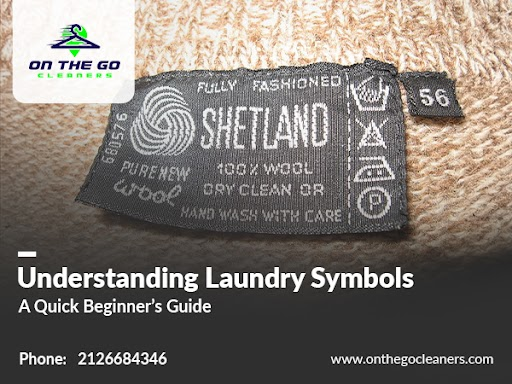The care label on the back of your favourite pair of jeans often has a number of symbols. Some look like a machine, a tumbler, or even an iron; others can be different shapes with letters inside them. To know how to care for a particular piece of cloth, the first step is to check the laundry care symbols.
On the garment tag of your dress, shirt, sweater, or jeans, you will find certain icons along with care instructions. While the icons on some tags may have a care instruction, others might not. These are called laundry symbols and instruct you on how to care for a particular garment. Thus, to avoid any damage when washing the garment, it is important to be aware of what the symbols indicate and instruct.
Let’s take a look at the common laundry care symbols and how they help you care for your garments.
Why Laundry Symbols Exist
Laundry symbols act as a guide, providing care instructions for the particular garment, which includes how to wash, dry, iron, bleach, and store them to preserve their quality and increase their lifespan. To increase convenience, these are standardized across the globe. Thus, no matter where your new garment is manufactured, the symbols instructing how to do laundry will remain the same.
The key reasons that make laundry symbols on clothes important are:
- Preventing damage to the material.
- Prolonging garment life.
- Instructing proper care.
- Saving time and money.
- Ensuring universal communication.
Thus, you no longer need to wonder, “Which laundry soap should I use?”, “Can you dry clean cotton?” or “Should you bleach wool?”
Let’s take a look at what happens when you ignore the care instructions on laundry day.
For instance, you have bought a silk shirt for the first time. Unknowingly, on laundry day, you soak this in a bucket full of hot water with powder detergent, and then put it in the washing machine and then the dryer. For those who don’t know, this is the fastest way to damage your new shirt.
In fact, once you take your shirt out of the dryer, you will find that the shirt has lost its lustre and softness, the material looking warped, dull, and brittle. This can also cause the color to bleed and seep into any other garment that you placed in the wash with it.
The lesson: Always know how to care for your garments. And the best place to learn where and how are the laundry symbols.
The Main Categories of Laundry Symbols
Based on their purpose, the symbols of the laundry symbol chart can be categorized into the following:
Washing Symbols
These include the bucket or tumbler-like symbols, the washing machine sign, bleach symbols, and ones of their kind. They instruct people how to wash their clothes, whether it needs hot water or cold, if you should hand-wash or machine-wash it, and whether it cannot be washed at all and needs to be dry cleaned.
The common washing symbols are:
- Tub (to indicate machine wash)
- Dots or numbers (to indicate the temperature of the water)
- A hand in tub (signifies handwashing)
- Crossed-out tub (do not wash)
Drying Symbols
These are meant for how one should dry a particular garment, whether it needs to be air dried, placed in the dryer, hung to dry, or dried on a flat surface.
The usual drying symbols are:
- Square with circle (tumble dry)
- Dots in the square with circle (drying temperature)
- Square + 3 vertical lines (hang dry)
- Square + 1 horizontal line (dry on flat surface)
- Square + 2 diagonal lines (dry in shade)
Ironing Symbols
Certain materials, like chiffon, wool, cashmere, and polyester, cannot be ironed. Others, like silk, need a lot of care. Cotton, denim, and similar materials can be ironed at high temperatures. Thus, it is important to know the ironing instructions, which can be learnt from the laundry symbols on clothes.
The ironing symbols that you may come across are:
- Iron (safe to iron)
- Iron + 1 dot (cool iron)
- Iron + 2 dots (medium heat)
- Iron + 3 dots (hot iron)
- Crossed out (do not iron)
Bleaching Symbols
Not every material, color, or garment can be bleached or bleached with the same solvent. Bleach symbols let people know if a certain garment can or cannot be bleached safely, while maintaining its texture, color, and other quality aspects.
The common bleach symbols are:
- Triangle (bleach as needed)
- Diagonal lines in triangle (non-chlorine bleach)
- Crossed-out triangle (no bleach)
Dry Cleaning Symbols
Certain materials, like silk, and garments with embellishments and prints cannot be washed at all. These need to be dry-cleaned periodically, a fact you can learn from the care label.
To learn if a garment can be dry cleaned, check the following symbol:
- Empty circle (can be dry cleaned)
- Circle with X (no dry cleaning)
- Circle with A (any solvent)
- Circle with F (petroleum-based solvent)
- Circle with P (PCE as solvent)
- Bars under circle (gentle dry cleaning/ reduced moisture)
- Candy-like shape with X (do not wring)
Real-Life Examples of Laundry Symbols on Common Fabrics
Most, if not all, of the garments we wear every day have laundry symbols on the tags. Let’s take a look at which laundry care symbols you may come across based on the cloth:
Cotton (T-Shirts, Everyday Wear)
On a cotton top or shirt, the symbols you will usually come across are a tub, a square with a circle, and an iron. These signs will indicate that the garment can be machine-washed at a certain temperature, tumble-dried in a dryer, and ironed at any temperature.
Wool (Sweaters, Suits)
Other than using the right laundry soap for wool, it is also important to look at the care symbols. These may include a tub with one dot to indicate mild temperature, hand wash, steam iron (or no iron), do not wring, and a flat dry symbol.
Silk (Blouses, Dresses)
When you do laundry for silk clothes, the instructions to follow can be similar to those for wool. These include washing at mild temperatures, do not machine or tumble dry, do not iron or iron at a low temperature, hand wash, and do not wring.
Polyester (Activewear, Jackets)
Your polyester activewear and jackets will usually have a hand wash, do not dry clean, do not tumble dry, do not iron, and, at times, a lay flat to dry symbol.
Denim (Jeans)
These usually have a machine wash, washing temperature, ironing temperature, do not bleach, do not tumble dry, and dry cleaning instructions.
Common Mistakes Beginners Make
As a beginner, you need to watch out for the following when it comes to reading the laundry symbol chart on laundry day:
- Misjudging the water temperature
- Ignoring bleach symbols
- Washing something that says do not wash
- Not opting for the right drying method
- Ironing at the wrong temperature
- Using bleach on a do-not-bleach material
- Using the wrong type of bleach
Quick Laundry Symbol Tips for Beginners
With too many laundry symbols available, it is very easy to mix them up as a beginner. Thus, at a glance, the things to remember for laundry symbols are:
- The tub symbol is for washing, the square sign for drying, the triangle is for bleach, and the circle indicates dry cleaning instructions.
- The dots indicate how intense the heat should be, i.e., the more dots more heat.
- Candy shape with an X means do not wring. Even if it is not there and you are washing a stretchable item, it is best not to wring it.
In case you are unable to understand what the symbol means, you can also refer to the fine print (usually given with the instruction symbols on the tag).
Wrapping Up
Before setting out to wash or dry-clean a new garment, it is important to be aware of the care instructions. This helps us clean the cloth the way it was supposed to be, and maintain its quality, finish, and longevity. Thus, every time we wash or dry-clean a new garment, it is important to check out the laundry symbols given on the tag.
Using Laundry Symbols to Care for Your Garments
Planning to wash a new garment? Check out the laundry instructions with help from our laundry symbol guide and get started.


